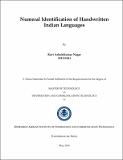Please use this identifier to cite or link to this item:
http://drsr.daiict.ac.in//handle/123456789/509Full metadata record
| DC Field | Value | Language |
|---|---|---|
| dc.contributor.advisor | Mitra, Suman K. | |
| dc.contributor.author | Nagar, Ravi Ashokkumar | |
| dc.date.accessioned | 2017-06-10T14:42:02Z | |
| dc.date.available | 2017-06-10T14:42:02Z | |
| dc.date.issued | 2014 | |
| dc.identifier.citation | Nagar, Ravi Ashokkumar (2014). Numeral identification of handwritten indian languages. Dhirubhai Ambani Institute of Information and Communication Technology, vii, 43 p. (Acc.No: T00472) | |
| dc.identifier.uri | http://drsr.daiict.ac.in/handle/123456789/509 | |
| dc.description.abstract | Automatic Speaker Verification (ASV) systems are prone to various spoofing attacks.Spoofing is one type of technique in which fake speech signal is given tothe ASV system to get the access of that system without the permission of anauthorized person. There are four types of spoofing attacks, namely, impersonation,replay, speech synthesis (SS) and voice conversion (VC). In impersonationattack, source speaker alter their voice (i.e., mimicking), replay attack record thespeech from target speaker voice, using any arbitrary text spoof speech can begenerated in speech synthesis, VC changes the voice of source-to-target speaker.SS and VC are more practical and they create more threat to the ASV system andhence, in this thesis work, we concentrate on the SS and VC only. For the detectionof spoofed speech, we develop various countermeasures, after analysis ofvarious plots and histograms of these features. We came up with the observationthat these countermeasures might work well, to classify whether these featuresare from natural or spoofed speech. For that purpose, we use GaussianMixture Model (GMM)-based classifier. We built two different GMM for naturaland spoofed speech. At the time of verification, when an unknown speech signalis given as an input to the ASV system, first features are extracted and afterthat, we find the likelihood score from both GMM models, which indicates theprobability of these features are from both the models. If this score is greater thansome threshold value, then it is classified as natural otherwise it is detected asspoofed speech. In this work, we propose linear prediction-nonlinear prediction(LP-NLP)-based countermeasure for the detection of spoofed speech signal. Forexperiments reported in this thesis, we used ASVspoof challenge 2015 databaseand database of Blizzard challenge 2012 and 2014. For the measurement of performanceof the system, we use Detection Error Tradeoff (DET) curve and EqualError Rate (EER). | |
| dc.publisher | Dhirubhai Ambani Institute of Information and Communication Technology | |
| dc.subject | Pattern Recognition | |
| dc.subject | Numerical Identification | |
| dc.subject | Recognition | |
| dc.subject | Handwritten Indian language | |
| dc.classification.ddc | 621.382 NAG | |
| dc.title | Numeral identification of handwritten indian languages | |
| dc.type | Dissertation | |
| dc.degree | M. Tech | |
| dc.student.id | 201211041 | |
| dc.accession.number | T00472 | |
| Appears in Collections: | M Tech Dissertations | |
Files in This Item:
| File | Description | Size | Format | |
|---|---|---|---|---|
| 201211041.pdf Restricted Access | 1.01 MB | Adobe PDF |  View/Open Request a copy |
Items in DSpace are protected by copyright, with all rights reserved, unless otherwise indicated.
